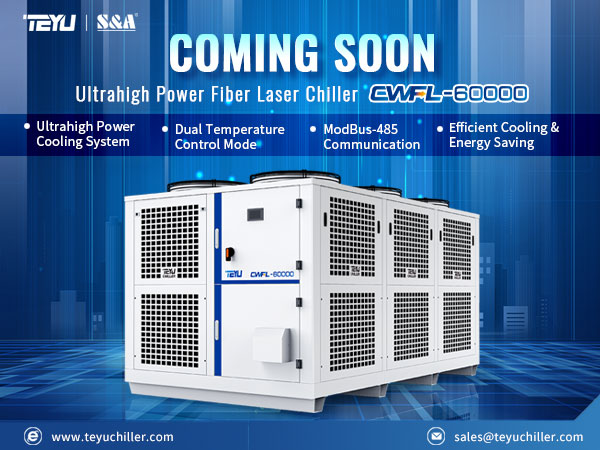Many people praise lasers for their ability to cut, weld, and clean, making them almost a versatile tool. Indeed, the potential of lasers is still immense. But at this stage of industrial development, various situations arise: the never-ending price war, laser technology facing a bottleneck, increasingly hard-to-replace traditional methods, etc. Do we need to calmly observe and reflect on the development issues we face?
TEYU Chiller's Thoughts on the Current Laser Development
The Never-ending Price War
Before 2010, laser equipment was expensive, from laser marking machines to cutting machines, welding machines, and cleaning machines. The price war has been ongoing. Just when you think you've made a price concession, there's always a competitor offering a lower price. Nowadays, there are laser products with a profit margin of only a few hundred yuan, even for selling marking machines worth tens of thousands of yuan. Some laser products have reached the lowest possible price, but the competition in the industry seems to be increasing rather than decreasing.
Fiber lasers with a power of ten kilowatts were worth 2 million yuan 5 to 6 years ago, but now they have dropped by nearly 90%. The money that used to buy a 10-kilowatt laser cutting machine can now buy a 40-kilowatt machine with money to spare. The industrial laser industry has fallen into the "Moore's Law" trap. Although it seems like technology is advancing rapidly, many companies in this industry are feeling the pressure. The price war looms over many laser companies.
Chinese Laser Products Are Popular Overseas
The intense price war and the three-year pandemic have unexpectedly opened up opportunities for some Chinese companies in foreign trade. Compared to regions like Europe, America, and Japan where laser technology is mature, China's progress in laser products has been relatively slower. However, there are still many developing economies around the world, such as Brazil, Mexico, Turkey, Russia, India, and Southeast Asia, which have decent manufacturing industries but have yet to fully adopt industrial laser equipment and applications. This is where Chinese companies have found opportunities. Compared to the high-priced laser machine tools in Europe and America, Chinese equipment of the same type is cost-effective and highly welcomed in these countries and regions. Correspondingly, the TEYU S&A laser chillers are also selling well in these countries and regions.
Laser Technology is Facing a Bottleneck
One criterion for assessing whether an industry still has full vitality is to observe if there are continuous new technologies emerging in that industry. The electric vehicle battery industry has been in the spotlight in recent years, not only because of its large market capacity and extensive industrial chain but also due to the constant emergence of new technologies, such as lithium iron phosphate batteries, ternary batteries, and blade batteries, each with different technological routes and battery structures.
Although industrial lasers seem to have new technologies every year, with power levels increasing by 10,000 watts annually and the emergence of 300-watt infrared picosecond lasers, there may be future developments like 1,000-watt picosecond lasers and femtosecond lasers, as well as ultraviolet picosecond and femtosecond lasers. However, when we look at it overall, these advancements only represent incremental steps on the existing technological path, and we haven't seen the emergence of truly new technologies. Since fiber lasers brought revolutionary changes to industrial lasers, there have been few disruptive new technologies.
So, What Will the Next Generation of Lasers Be?
Currently, companies like TRUMPF dominate the field of disc lasers, and they have even introduced carbon monoxide lasers while maintaining a leading position in extreme ultraviolet lasers used in advanced lithography machines. However, most laser companies are facing significant obstacles and bottlenecks in promoting the emergence and development of new laser technologies, which forces them to focus on the continuous refinement of existing mature technologies and products.
Increasingly Hard to Replace Traditional Methods
The price war has led to a wave of technological iteration in laser equipment, and lasers have penetrated many industries, gradually phasing out older machines used in traditional processes. Nowadays, whether in light industries or heavy industries, many sectors have more or less adopted laser production lines, making it increasingly challenging to achieve further penetration. The capabilities of lasers are currently limited to material cutting, welding, and marking, while processes such as bending, stamping, complex structures, and overlapping assembly in industrial manufacturing have no direct connection to lasers.
Currently, some users are replacing low-power laser equipment with higher-power laser equipment, which is considered an internal iteration within the laser product range. Laser precision processing, which has gained popularity, is often confined to a few industries such as smartphones and display panels. In the recent 2 to 3 years, there has been some equipment demand driven by industries like electric vehicle batteries, agricultural machinery, and heavy industries. However, the scope for new application breakthroughs is still limited.
In terms of successful exploration of new products and applications, handheld laser welding has shown promise. With lower prices, tens of thousands of units are shipped each year, making it far more effective than arc welding. However, it should be noted that laser cleaning, which was popular a few years ago, did not see widespread adoption as dry ice cleaning, which costs only a few thousand yuan, eliminated the cost advantage of lasers. Similarly, plastic laser welding, which received much attention for a while, faced competition from ultrasound welding machines that cost a few thousand yuan but were functioning well despite their noise levels, hindering the development for plastic laser welding machines. While laser equipment can indeed replace many traditional processing methods, for various reasons, the possibility of substitution is becoming increasingly challenging.

We're here for you when you need us.
Please complete the form to contact us, and we'll be happy to help you.










































































































